Have you ever caught yourself glancing at your phone or adjusting music while driving, only to realize you missed a turn or a traffic signal?
It happens to everyone, but even a brief distraction can lead to serious accidents.
Driving requires constant attention, and learning to minimize distractions is one of the most effective ways to stay safe on the road.
<h3>Put Devices Out of Reach</h3>
Smartphones are the most common source of distraction. Notifications, calls, and texts compete for your attention, even for a second. Highly focused drivers keep their phone out of reach, in a glove compartment or the back seat, and use hands-free options for essential calls. Many also activate “Do Not Disturb” modes specifically for driving. Out of sight, out of mind, ensures your attention stays on the road.
<h3>Set Up Your Vehicle Before Driving</h3>
Adjusting mirrors, seat position, climate control, or GNSS while driving is risky. Safe drivers handle these tasks before starting the engine. Pre-setting music playlists or routes minimizes mid-drive adjustments. For instance, selecting your destination on a navigation app before moving allows you to focus entirely on traffic and surroundings rather than fumbling with devices on the go.
<h3>Limit Multi-Tasking</h3>
Eating, drinking, or reaching for items while driving may seem harmless, but it splits your attention. Even simple tasks like sipping coffee or opening a snack can delay reaction times. Focused drivers avoid multitasking completely, treating driving as their primary responsibility. Keeping drinks in spill-proof containers and having essential items within reach before starting the journey can reduce temptation.
<h3>Use Voice Commands and Smart Features</h3>
Modern vehicles offer hands-free systems for calls, messaging, and navigation. Voice commands allow you to interact without taking your eyes off the road. For example, asking a virtual assistant to change a song or read a message aloud keeps your hands on the wheel and eyes ahead. Safe drivers use these features strategically rather than relying on manual controls mid-drive.
<h3>Stay Mindful of Passengers</h3>
Passengers can unintentionally distract drivers with conversation, movement, or requests. Highly attentive drivers set boundaries by politely asking passengers to avoid sudden interruptions. Encouraging calm, focused interaction inside the car helps maintain a safe environment. This is especially important when driving with children, pets, or nervous passengers.
<h3>Take Breaks on Long Drives</h3>
Fatigue is a form of distraction. On long journeys, your attention can drift, even if you're not using devices or eating. Safe drivers schedule regular breaks to stretch, hydrate, and refresh. A short 10–15 minute pause every two hours helps maintain alertness and prevents lapses that could result in dangerous situations.
<h3>Anticipate Road Hazards</h3>
Distractions aren't always about devices or passengers; unexpected events on the road can pull your focus in the wrong direction. Focused drivers continuously scan the environment for hazards—brake lights, sudden lane changes, or pedestrians near crosswalks. Anticipating potential problems lets you react calmly and prevents overreliance on sudden reflexes, reducing accident risk.
Minimizing distractions isn't about eliminating all comfort or convenience—it's about prioritizing safety and attention. These habits—keeping devices out of reach, pre-setting vehicle controls, using voice commands, and staying alert—work together to create a focused driving experience. Even a single lapse of attention can have serious consequences, but with consistent practice, staying attentive becomes second nature.
Next time you sit behind the wheel, take a moment to organize your space, silence your phone, and prepare your route. The small effort of reducing distractions can make every journey safer, smoother, and less stressful. Staying focused doesn't just protect you—it protects everyone sharing the road with you.





